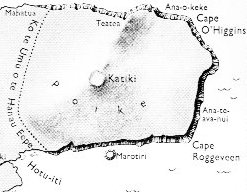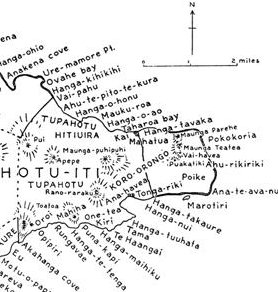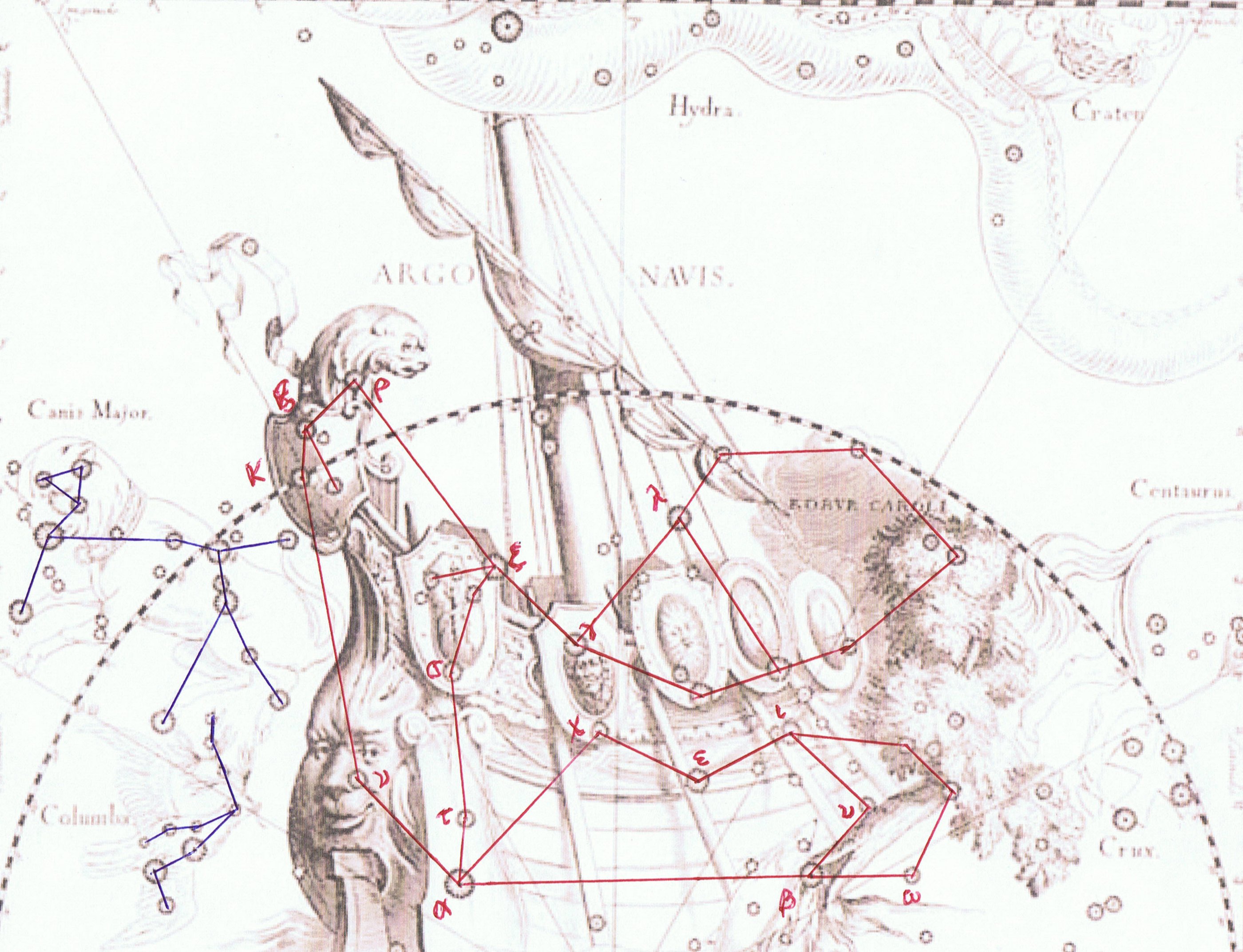According to
Manuscript E the
kuhane of
Hau Maka
flew over Easter
Island in the
night following
the southern
coastline and
then turned towards
the north at
Hanga Takaure.
Going north from
Hanga Takaure
means moving
upwards, because
the peninsula
Poike ('the
place aloft') is high
ground.

... The dream
soul went on and
came to One
Tea. She
named the place
'One Tea A
Hau Maka O Hiva'.
She went on and
reached Hanga
Takaure. She
named the place
'Hanga
Takaure A Hau
Maka O Hiva'.
The position of
Hanga Taka-Ure
is
precisely where
the strange
geographical
feature of Ko
te Umu o te
Hanau Eepe
(the Earth-oven
for the
thick-set race,
'the Long-ears')
is beginning.
... The Long-ear
people were
strong, they
ruled. They
lived out there
on Poike, the
headland, where
the ground is
not covered with
heavy stones.
They stretched
their ears with
ornaments, those
people, they
made them long
...

|
Taka
Taka,
takataka.
Circle;
to form
circles,
to
gather,
to get
together
(of
people).
Vanaga.
1. A
dredge.
P Mgv.:
akataka,
to fish
all day
or all
night
with the
line, to
throw
the
fishing
line
here and
there.
This can
only
apply to
some
sort of
net used
in
fishing.
We find
in Samoa
ta'ā
a small
fishing
line,
Tonga
taka
the
short
line
attached
to fish
hooks,
Futuna
taka-taka
a
fishing
party of
women in
the reef
pools
(net),
Maori
takā
the
thread
by which
the
fishhook
is
fastened
to the
line,
Hawaii
kaa
in the
same
sense,
Marquesas
takako
a badly
spun
thread,
Mangareva
takara
a thread
for
fastening
the bait
on the
hook. 2.
Ruddy.
3.
Wheel,
arch;
takataka,
ball,
spherical,
round,
circle,
oval, to
roll in
a
circle,
wheel,
circular
piece of
wood,
around;
miro
takataka,
bush;
haga
takataka,
to
disjoin;
hakatakataka,
to
round,
to
concentrate.
P Pau.:
fakatakataka,
to whirl
around.
Mq.:
taka,
to gird.
Ta.:
taa,
circular
piece
which
connects
the
frame of
a house.
Churchill.
Takai,
a curl,
to tie;
takaikai,
to lace
up;
takaitakai,
to coil.
P Pau.:
takai,
a ball,
to tie.
Mgv.:
takai,
a
circle,
ring,
hoop, to
go
around a
thing.
Mq.:
takai,
to
voyage
around.
Ta.:
taai,
to make
into a
ball, to
attach.
Churchill. |
|
Ure
1.
Generation;
ure
matß,
warlike,
bellicose
generation
(matß,
obsidian,
used in
making
weapons).
2.
Offspring;
brother;
colleague
i
toou ure
ka
tata-mai,
your
colleague
has
turned
up. 3.
Friendship,
friendly
relationship;
ku-kÚ-ß
te ure,
they
have
become
enemies
(lit.:
friendship
has
changed).
4. Penis
(this
definition
is found
in
Englert's
1938
dictionary,
but not
in La
Tierra
de Hotu
Matu'a).
Ure
tahiri,
to gush,
to
spurt,
to flow;
e-ure
tahiri-ß
te toto,
blood is
flowing
in
gushes.
Ure
tiatia
moana,
whirlwind
which
descend
quickly
and
violently
onto the
ocean;
whirlpool,
eddy.
Vanaga.
Penis;
kiri
ure,
prepuce,
foreskin.
P Pau.,
Mgv.,
Ta.:
ure,
penis.
Ureure,
spiral.
Ta.:
aureure,
id.
Urei,
to show
the
teeth.
Mgv.:
urei,
to
uncover
the eye
by
rolling
back the
lids.
Churchill.
Pau.:
Ureuretiamoana,
waterspout.
Ta.:
ureuretumoana,
id.
Churchill.
H.
Ule
1.
Penis.
For
imaginative
compounds
see
'a'awa
1,
'aweule,
ulehala,
ulehole,
ulepa'a,
ulepuaa,
ule'ulu.
Kū ka
ule,
he'e ka
laho,
the
penis is
upright,
the
scrotum
runs
away
(refers
to
breadfruit:
when the
blossom
(pōule)
appears
erect,
there
will
soon be
fruit).
2. Tenon
for a
mortise;
pointed
end of a
post
which
enters
the
crotch
of a
rafter
(also
called
ma'i
kāne).
Ho'o
ule,
to form
a tenon
or post
for the
crotch
of a
rafter.
3. To
hang.
Wehewehe. |
In legend this is the
ditch of fire
(an 'earth oven',
umu) where the
'Long-ears'
where
exterminated,
and presumably it
alludes to 10h,
which time
according to ancient
tradition
possibly was
regarded as the
hottest time of
the year.
... One of
the final
rites
consisted in
a frenzied
dance which
was
prolonged
until after
dark, in
spite of the
exhausted
state of the
participants.
The
Arapaho
called it
'gambling
against the
sun', and
the
Gros-Ventre
'the dance
against the
sun'. The
aim was to
counteract
the
opposition
of the
intense heat
of the sun,
who had
tried to
prevent the
ceremony
taking place
by radiating
his warm
rays every
day during
the period
preceding
the dance
...
The Indians,
then, looked
upon the sun
as a dual
being:
indispensable
for human
life, yet at
the same
time
representing
a threat to
mankind by
its heat, a
presage of
prolonged
drought. One
of the
motifs of
the
Arapaho
dancers'
body-paintings
shows them
being
'consumed by
fire' ...
|
Umu
Cooking
pit,
Polynesian
oven
(shallow
pit
dug
in
the
ground,
in
which
food
is
cooked
over
heated
stones);
the
food
cooked
in
such
a
pit
for
a
meal,
dinner,
or
banquet;
umu
pae,
permanent
cooking
pit,
in a
stone
enclosure.;
umu
paepae,
permanent
cooking
pit
with
straw
cover
for
protection
from
rain
and
wind;
umu
keri
okaoka,
temporary
cooking
pit
without
stone
enclosure;
umu
ava,
very
large
temporary
cooking
pit,
made
for
feasts;
umu
takap˙,
exclusive
banquet,
reserved
for
certain
groups
of
persons,
for
instance
the
relatives
of a
deceased
family
member;
umu
tahu,
daily
meals
for
hired
workers;
umu
parehaoga,
inaugural
banquet
(made
on
occasion
of a
communal
enterprise
or
feastival);
umu
ra'e,
banquet
for
fifth
or
sixth
month
of
pregnancy;
umu
pÔpaku,
banquet
on
occasion
of
the
death
of a
family
member.
Vanaga.
Cooking
place,
oven
(humu).
Churchill.
Samoa,
Maori,
Nukuoro,
Niue,
Tahiti,
Hawaii,
Mangaia,
Marquesas,
Mangareva,
Paumoto:
umu,
oven.
Tonga:
ngotoumu,
id.
Uvea:
ngutu¨mu,
id.
Futuna:
¨mu-kai,
id.
Fotuna:
amu,
cooking
place.
Rapanui:
umu,
oven;
humu
hare,
cook
house
...
The
Polynesian
radical
is
consistently
umu.
Tonga
and
Uvea
compound
with
it a
word
which
in
Uvea
is
distinctly
ngutu
mouth
and
in
Tongan
we
may
feel
that
ngutu
has
been
specifically
differentiated
in
this
composite.
In
the
Futuna
composite
the
latter
element
is
merely
kai
food
...
Particular
interest
attaches
to
the
discovery
of
the
amu
type
in
Mabulag
and
Miriam,
western
and
eastern
islands
of
the
straits
and
remote
from
the
New
Guinea
coast
...
The
existence
of
amu
in
Fotuna
affords
us
reason
to
regard
the
type
as
ancient
Proto-Samoan,
and
that
Mabulag
and
Miriam
received
it
directly
and
not
on
secondary
loan
from
Motu.
Churchill
2. |
I guess we should
pinpoint
Hanga Takaure
on our C map as August
21-24:
| Hanga Takaure |
| An Nathra 5 |
6 |
7 |
8 (100) |
| August 21 |
22 |
23 |
24 (236) |
 |
 |
 |
 |
| Ca6-13 |
Ca6-14 |
Ca6-15 |
Ca6-16 |
| manu teketeke ki ruga |
takaure |
kua aha te takaure |
i te henua ma te rima |
| Sadalmelik (334.6) |
|
|
|
| Regulus (152.7), λ Hydrae (153.2) |
no star listed |
Simiram, Adhafera, Tania Borealis (154.7), Algieba (155.5) |
Tania Australis(156.0) |
The end
of the
southern
coastline
flight
of the
kuhane
should
then be with
manzil
night
100 (=
Gregorian
day
236). In
manzil
day 101
her path
upwards
would
begin,
with RA
night
157 (=
314 /
2). 80 +
157 =
237 =
136 +
101.
(233 +
234 +
235 +
236) / 2
= 469
(i.e. 1
more
than
468).
(61 * 3
+ 61 * 4
+ 61 * 5
+ 61 *
6) / 3
= 183.
In G a
slightly
different
map
seems to
be used,
maybe
beginning
4 days
earlier
than
Regulus:
 |
 |
 |
| Ga3-23 (*146) |
Ga3-24 |
Ga4-1 (85) |
| Subra (145.8), ψ Leonis (146.4) |
Ras Elaset Australis (146.6) |
Vathorz Prior (147.9), υ╣ Hydrae (148.4) |
| August 14 |
15 |
16 (228) |
| Murzim 11 |
12 |
13 (92) |
 |
 |
 |
 |
 |
 |
| Ga4-2 |
Ga4-3 |
Ga4-4 |
Ga4-5 |
Ga4-6 (90) |
Ga4-7 |
| Ras Elaset Borealis (148.7) |
Tseen Ke (149.9), ν Leonis (150.1) |
π Leonis (150.6) |
10h (152.2) |
Regulus (152.7), λ Hydrae (153.2) |
no star listed |
| υ▓ Hydrae (151.8), Al Jabhah (152.4) |
| August 17 |
18 |
19 |
20 (232) |
21 |
22 |
| An Nathra 1 |
2 |
3 |
4 |
5 |
6 |
The star Tseen Ke is φ Velorum and according to Hevelius located at the last shield, before my red line leads up to the top of the oak Robur Carolinum:

... Robur Carolinum, Charles' Oak, the Quercia of Italy and the Karlseiche of Germany, was formally published by Halley in 1679 in commemoration of the Royal Oak of his patron, Charles II, in which the king had lain hidden for twenty-four hours after his defeat by Cromwell in the battle of Worcester, on the 3rd of September 1651 ...
But perhaps the whole hexagonal fore sail, from λ (Alsuhail) to μ (Peregrini, up in the Oak) covers Hanga Takaure.
Peregrini (162.6) - Alsuhail (137.5) = 25 days (a square of 'fire'):
 |
 |
21 |
| Ga3-14 (74) |
Ga3-15 |
| 9h (137.0) |
Alsuhail (137.5), σ▓ Ursa Majoris (137.6), τ Ursa Majoris (137.7), ξ Cancri (137.8) |
| ω Hydrae (136.8), σ╣ Ursa Majoris (137.0), κ Cancri (137.3) |
| August 5 (217) |
6 |
| Murzim 2 (81) |
3 |
 |
 |
 |
| Ga4-13 (*160) |
Ga4-14 |
Ga4-15 |
| φ Hydrae (160.3) |
no stars listed |
| August 28 |
29 |
30 (242) |
| An Nathra 12 |
13 |
Alterf 1 (106) |
 |
 |
 |
 |
| Ga4-16 (100) |
Ga4-17 (*164) |
Ga4-18 |
Ga4-19 |
| Peregrini (162.6), ν Hydrae (163.1) |
no stars listed |
Alkes (165.6), Merak (166.2) |
| August 31 |
September 1 (244) |
2 |
3 |
| Alterf 2 (107) |
3 |
4 |
5 |
August 31 (243) coincides with manzil day 107 and also with glyph 100.
|
















